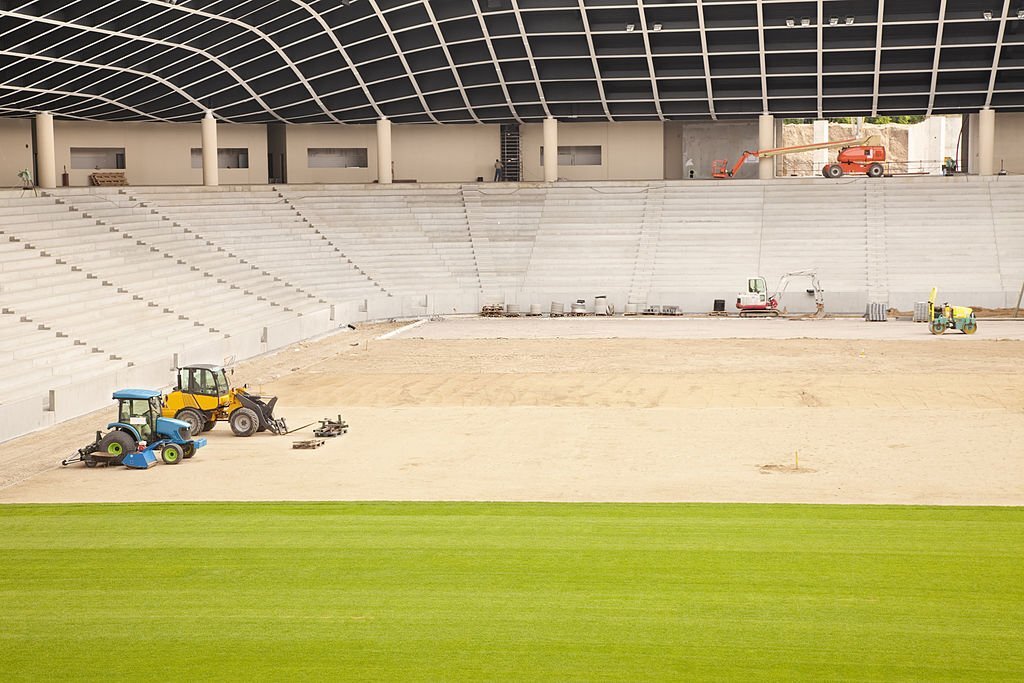Sports Field Construction: Cost Calculations And Construction Methods
The costs in sports field construction depend on numerous factors and vary depending on the construction of the sports field. The construction of a natural turf field presents the sports field builder with different challenges compared to the construction of a new artificial turf field. Sports fields with hybrid turf systems are increasingly being installed in municipal areas, and there are also different types of construction.
DIN 18035-4 describes in detail which requirements a sports turf surface has to meet. Sufficient water permeability and the ability to store moisture and nutrients are prerequisites for a high level of vegetation and are among the central tasks in sports field construction. This ensures that the natural turf retains its optimal properties and that the sports facility can be used frequently and intensively. Compliance with the standard ensures that sports fields are built according to a uniform scheme throughout world and that regional differences hardly need to be taken into account when choosing the seed and the lawn mixture.
Examples of construction methods in sports field construction with hybrid grass
- Example 1: In this example, the turf base layer lies directly on the subsoil. Mixing interlocking creates a connection between the base course and the subsoil. The basic prerequisite is the sufficiently permeable nature of the subsoil to be able to carry out such a construction.
- Example 2: With this type of construction, drain lines are installed at regular intervals of 8 to 10 m with a collector connection. Washed sand rich in coarse sand is then applied and mixed with the subsoil. The exact amount of sand depends on the permeability of the subsoil.
- Example 3: With this type of construction, an intermediate layer of medium-coarse sand can be produced to improve water permeability and an intermediate layer can be built in to improve water storage. A system of drainage rods and drainage slots is created and filled with gravel or grain-stable chippings 2/8 mm to 30 mm above the formation level.
- Example 4: This construction is standard in the upscale amateur sector, in professional sports and in stadiums. A playing field of this construction defies even the most adverse weather conditions and is extremely hard-wearing. Drainage rods are installed at intervals of 5 to 8 m with a collector connection and a sandy drainage layer is applied. The drainage layer is finally interlocked with the turf base layer.
You can use the natural turf cost calculator to calculate the exact costs for building a sports field with natural turf pitches. You will also find in the overview of the cost calculator, calculations for the new construction of a hybrid or artificial turf pitch.
How long does the construction of the sports field take?
Sports field construction projects are often lengthy processes that often require several months of preparation and patience until the financing is secured and the basic building regulations are clarified. That is why we try in principle to support the clubs and municipalities in advancing their project without incurring planning costs with the first ideas and work. The construction of an artificial turf pitch takes place during the frost-free season with Reform Spor and only takes about 5 to 8 weeks. The course can be played immediately. A natural turf field can be made playable in 14 weeks, provided the sowing and completion care can still take place in the warm season. Otherwise you have to wait until next year.
Which legal and technical requirements must be observed when building a sports field?
Depending on the location and the individual requirements of the client, a large number of laws, regulations, provisions and DIN standards must be observed when building sports grounds. DIN 18035 is the technical set of rules for the construction of outdoor sports facilities. Extensive specifications for the construction of sports facilities that are suitable for competitions and open to the rules as well as for the safety equipment, irrigation and drainage, the structure and the choice of materials must be observed in order to ensure that the game can continue to operate over the long term.
The main legal requirements are provided by the building code and the state building code as well as the laws and ordinances on emissions, places of assembly, water management, noise, nature and soil protection. For the implementation of competition events, the competition rules of the sports associations must also be observed when planning the sports facility.
Which preliminary examinations of the sports facility are required for planning?
The measurement of the sports facility and the subsoil report required for the construction of the field, floodlight mast foundations and drainage as well as the light and noise emission report are a prerequisite for every sports field construction project, as they enable a high level of planning and cost security. In addition, the investigations of the soil conditions and the existing sports field construction provide the necessary information for the ideal field structure and the reusability of existing sports field materials according to applicable technical standards. The costs for the preliminary examinations are usually eligible.

